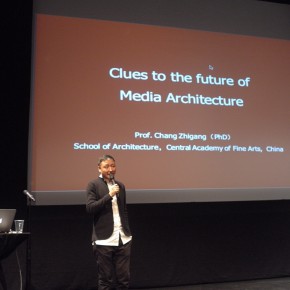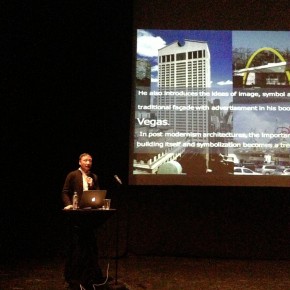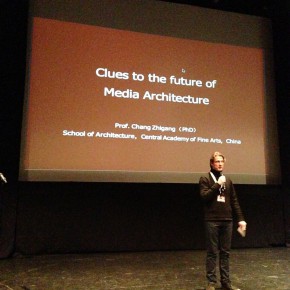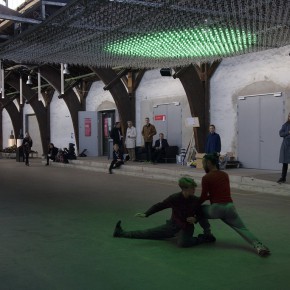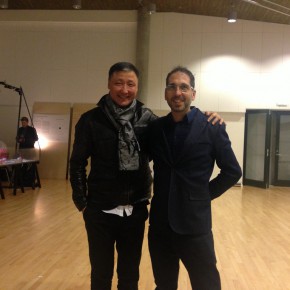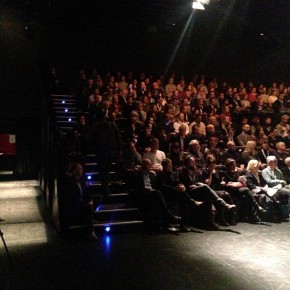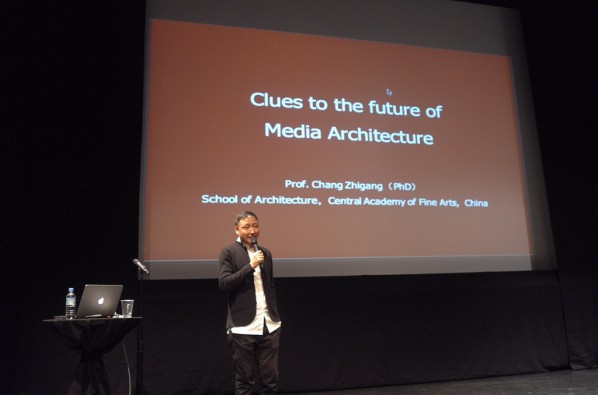
The Media Architecture Biennale (MAB) 2014 was jointly hosted by the University of Aarhus, Denmark and the Media Architecture Institute, and supported by several academic institutions, design organizations and enterprises including the Copenhagen and Aarhus government, as well as Connecting city, the Danish Architecture Center and ONLYGLASS.
Media Architecture generates the intersection of physical space and digital space, bringing a real challenge and opportunity, it requires a form that is able to be understood, while transcending traditional architecture and media art (design). At present, such an intersection is still growing stable and generates a large number of products, such as the “media facade, mobile applications, social media, mobile location services, urban screening, intelligent environment”, and these elements are integrated, to some extent, in constant changes and redefinition. Media Architecture is creating a new media form in urban spaces. In general, the innovation of media architecture lies mainly in several aspects: new hardware (the facade system), new applications( interaction games) and new architectural forms; while the biggest innovation is the combination of these aspects and means.
Themed “World Cities”, the media architecture biennale brings together pioneers and explorers who are from a variety of cities and have diversified thoughts, including architects, designers, academia, artists, industry experts, and governments, and the participants discussed topics such as the role of media architecture in the future urban developments as well as the strategy of media architecture to actively deal with the theme “world cities”, based on a discussion on the huge developing potential of media architecture in the fields of society, culture and business.
The biennale lasted for three days (December 11, 2014 to December 22, 2014), composed of an academic conference, series of seminars, exhibition and an award ceremony. The main venue was located in Godsbanen and the Library of Aarhus, Gernot Tscherteu, founder of Media Architecture Institute and Professor Morten Lervig from the University of Aarhus jointly served as the curators, it is by far the largest media architecture exhibition in the world – showcasing 80 media architecture cases from all over the world, as well as related works by 35 artists and art groups, including Kollision, Senseable City lab at the Massachusetts Institute of Technology, Higher Visual and Interaction Center at the University of Aarhus, Aram Bartholl, Tobias Ebsen, Aarhus Electronic Future Laboratory, Media Architecture Institute, Christian Zollner, Julian Adenauer, Daniel Iregui, Ortlos, etc.
A variety of thematic discussions, academic conferences were interspersed with exhibitions, including more than 10 venues such as Interactive Urban Architecture, Industry Round Table, and Mapping Media Layer, hosted by the well-known professors from the universities such as the University of Aarhus, University of Munich, Bauhaus University and UCL Bartlett.
Academic conferences were held in collaboration with the ACM, including more than 10 academic talks and panels. Professor Chang Zhigang, Deputy Dean of the School of Architecture, CAFA was the only special guest from Asia, together with other 12 honored guests such as Simon Ewings (an architect from Snøhetta Studio), Uwe R. Bruckner (Director of ATELIER BRÜCKNER Studio), Daan Roosegaarde (Director of Studio Roosegaarde), Adam Greenfield (founder of Urbanscale), Jan Edler (partner of Realities: United Studio) and Thorsten Bauer (Creative Director of URBANSCREEN), who gave the keynote speech.
The academic conference was jointly presided over by Chairman Martin Brynskov and Gernot Tscherteu. Aarhus’s Mayor Jacob Bundsgaard addressed the opening ceremony and said: “The media architecture and intelligent city is one of the directions of the urban construction in the 21st century, and Aarhus will take it as an important strategy to be integrated into the blueprint for the future city development, and try to use it as a new urban development model and expand it throughout the world.”
Professor Chang Zhigang gave a speech entitled “Clues to the Future of Media Architecture” at the main venue “Black Box”, from the perspective of architectonics, systematically combing through and analyzing the historic context and the developmental trend of media architecture: first of all, media architecture was not only the product of digital science and technology and building technology, but also the mutation of a variety of elements such as nature, culture and technology which integrated with art, which was a qualitative change diverted from building ontology, a new thing, a paradigm of architectural reconstruction. Image media covered the “interface” of building, through communication and interaction with the audience, influencing the visual aesthetic experience of people, dominating the urban appearance, therefore building ontology was transformed to a media “interface” from the substantive “construction” in the traditional sense. Secondly, media architecture was an organic part of the intelligent city, rather than staying on the level of a visual feast of architecture and city produced by the use of digital design, it was the entry of the physical space and virtual space, that providesa device and platform for interactive activities, so that the spatial (real and virtual) exchange would qualitatively leap forward so as to realize the comprehensive links and effective organization of urban space, aimed at finishing comprehensive urban spatial communication, becoming the carrier of “intelligent life”. Thirdly, architecture, media and public art would be integrated so as to be an organic whole, while architects, artists, and network media experts would become the creators of media art and public art in urban space, taking the real city as the stage, to promote the interactive, participatory, publicity, social, complexity and influence for the work to reach an unprecedented height. Fourthly, media architecture was a challenge for the career of an architect and even architectural education. In addition to the traditional architecture courses, architectural education should also focus on visual communication, advertising planning, media interaction, installation art, public art and other fields, the comprehensive coordination ability, cross-border integration ability and social sensitivity was far more important than the proficient professional routine.
In the Q & A section, the on-site audiences were very interested in the development of Chinese media architecture. Professor Chang answered the questions one by one. In addition, Dr. M. Hank Haeusler, Chairman of the Media Architecture Institute hoped to jointly organize the Media Architecture Summit with CAFA in 2015, so deepening the cooperation between the Media Architecture Institute and the School of Architecture, CAFA.
The Award ceremony was the finial activity of the biennale, rewarding the excellent projects that had made outstanding contributions in a variety of cross fields such as architecture, media and interaction design, and the award was divided into five categories: Animated Architecture, Spatial Media Art, Participatory Architecture and Urban Interaction, Money Architecture, Future Trends and Prototypes, etc., among them, Wuhan Hanjie Wanda Plaza project, China won the Money Architecture prize.
Photo and text by Media Architecture Studio of CAFA
Translated by Chen Peihua and edited by Sue/CAFA ART INFO


